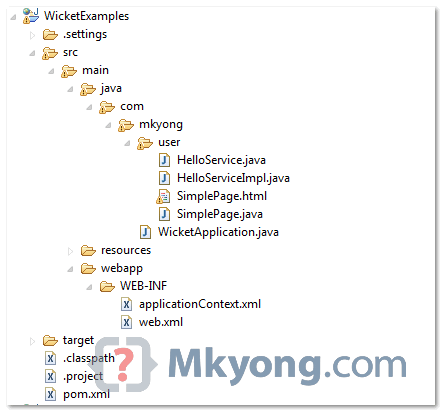wicket 集成 spring
1. Project Structure
Final project directory structure of this tutorial, nothing special, just a standard Maven project.
2. Project Dependency
Get Wicket and Spring dependencies, to integrate both, you need “wicket-spring.jar“.
<dependencies> <!-- Wicket framework--> <dependency> <groupId>org.apache.wicket</groupId> <artifactId>wicket</artifactId> <version>1.4.17</version> </dependency> <!-- Integrate Wicket with Spring --> <dependency> <groupId>org.apache.wicket</groupId> <artifactId>wicket-spring</artifactId> <version>1.4.17</version> </dependency> <!-- Spring framework --> <dependency> <groupId>org.springframework</groupId> <artifactId>spring-core</artifactId> <version>3.0.5.RELEASE</version> </dependency> <dependency> <groupId>org.springframework</groupId> <artifactId>spring-context</artifactId> <version>3.0.5.RELEASE</version> </dependency> <dependency> <groupId>org.springframework</groupId> <artifactId>spring-web</artifactId> <version>3.0.5.RELEASE</version> </dependency> <!-- slf4j-log4j --> <dependency> <groupId>org.slf4j</groupId> <artifactId>slf4j-log4j12</artifactId> <version>1.5.6</version> </dependency> </dependencies>
3. Spring Bean
Create a Spring bean, annotate it with @Service .
package com.mkyong.user;
public interface HelloService {
String getHelloWorldMsg();
}
package com.mkyong.user;
import org.springframework.stereotype.Service;
@Service
public class HelloServiceImpl implements HelloService {
public String getHelloWorldMsg() {
return "Spring : hello world";
}
}
4. Inject into Spring container
Create a standard Spring applicationContext.xml file, enable the auto component scanning feature.
File : applicationContext.xml
<beans xmlns="http://www.springframework.org/schema/beans" xmlns:xsi="http://www.w3.org/2001/XMLSchema-instance" xmlns:context="http://www.springframework.org/schema/context"> <context:component-scan base-package="com.mkyong.user"/> </beans>
5. Integrate Wicket with Spring
Override Wicket application init() method with this “addComponentInstantiationListener(new SpringComponentInjector(this));“.
File : Wicket application class
package com.mkyong;
import org.apache.wicket.protocol.http.WebApplication;
import org.apache.wicket.spring.injection.annot.SpringComponentInjector;
import com.mkyong.user.SimplePage;
public class WicketApplication extends WebApplication {
@Override
public Class<SimplePage> getHomePage() {
return SimplePage.class; // return default page
}
@Override
protected void init() {
super.init();
addComponentInstantiationListener(new SpringComponentInjector(this));
}
}
Now, you can inject Spring bean into Wicket component via @SpringBean.
package com.mkyong.user;
import org.apache.wicket.PageParameters;
import org.apache.wicket.markup.html.basic.Label;
import org.apache.wicket.markup.html.WebPage;
import org.apache.wicket.spring.injection.annot.SpringBean;
public class SimplePage extends WebPage {
@SpringBean
private HelloService helloService;
public SimplePage(final PageParameters parameters) {
add(new Label("msg", helloService.getHelloWorldMsg()));
}
}
<html> <body> <h1>Wicket + Spring integration example</h1> <h2 wicket:id="msg"></h2> </body> </html>
6. web.xml
Last step, make your web project know what is Wicket and Spring. Declares both in web.xml.
File : web.xml
<?xml version="1.0" encoding="ISO-8859-1"?> <web-app xmlns="http://java.sun.com/xml/ns/j2ee" xmlns:xsi="http://www.w3.org/2001/XMLSchema-instance" xsi:schemaLocation="http://java.sun.com/xml/ns/j2ee http://java.sun.com/xml/ns/j2ee/web-app_2_4.xsd" version="2.4"> <display-name>Wicket Web Application</display-name> <filter> <filter-name>wicket.wicketTest</filter-name> <filter-class>org.apache.wicket.protocol.http.WicketFilter</filter-class> <init-param> <param-name>applicationClassName</param-name> <param-value>com.mkyong.WicketApplication</param-value> </init-param> </filter> <filter-mapping> <filter-name>wicket.wicketTest</filter-name> <url-pattern>/*</url-pattern> </filter-mapping> <listener> <listener-class> org.springframework.web.context.ContextLoaderListener </listener-class> </listener> </web-app>
7.具体的方法要根据相应jar包支持的最新版本进行转换。
